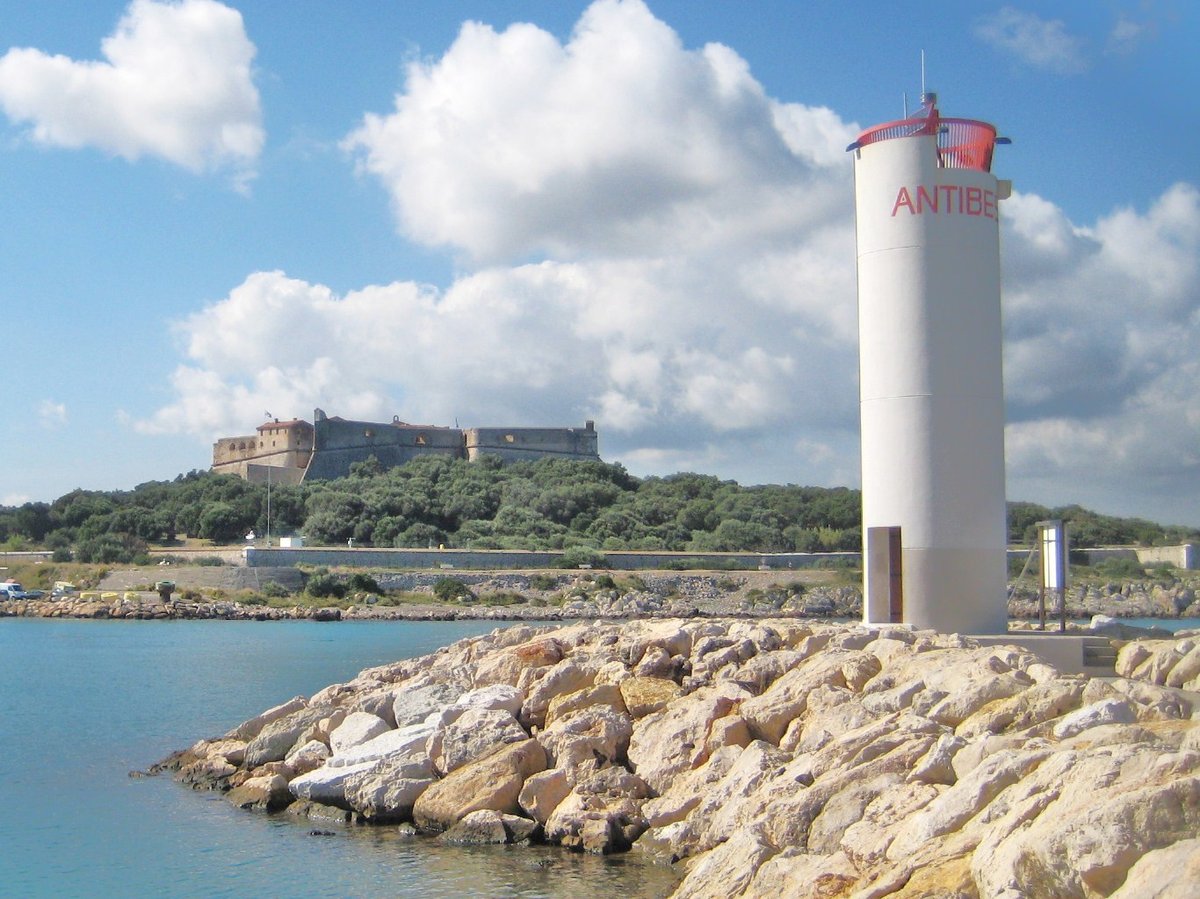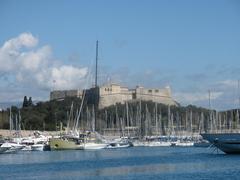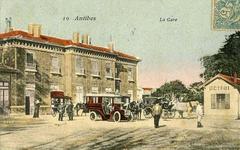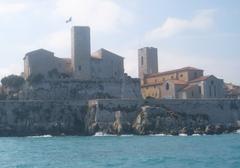
Visiting Fort Carré in Antibes: Hours, Tickets, and Tips
Date: 18/07/2024
Introduction
Perched atop the Saint-Roch peninsula in Antibes, France, Fort Carré is an iconic star-shaped fortress that offers a rich tapestry of history, architecture, and culture. Known for its strategic significance, this fortress has witnessed numerous historical events and transformations since its inception in the 16th century. Originally commissioned by Duke Emmanuel Philibert of Savoy, the fort was significantly enhanced in the latter half of the 17th century by the renowned military engineer Sébastien Le Prestre de Vauban under the directive of King Louis XIV.
Vauban’s innovative design and military genius are evident in Fort Carré’s unique star-shaped layout, which was a revolutionary approach to fortification at the time. Over the centuries, it has served various roles, from a military outpost to a prison, and now stands as a preserved historical monument open to the public. This comprehensive guide aims to delve deep into the fascinating history of Fort Carré, provide essential visitor information, and highlight key features and nearby attractions that make it a must-visit site on the French Riviera.
Table of Contents
- Introduction
- The Genesis of a Stronghold - Early Beginnings (16th Century)
- The Vision of Vauban - A Military Masterpiece Takes Shape (17th Century)
- A Legacy of Resilience - From Military Outpost to Prison (18th-19th Centuries)
- A New Era - From Military Relics to Cultural Heritage (20th Century - Present)
- Visiting Fort Carré - Hours, Tickets, and Tips
- Special Events, Guided Tours, and Photography Spots
- Exploring the Layers of History - Key Features and Their Significance
- FAQ Section
- Conclusion and Call to Action
The Genesis of a Stronghold - Early Beginnings (16th Century)
The story of Fort Carré begins in the 16th century when Antibes, then known as Antipolis, held a strategically vital position on the French-Savoyard border. Recognizing the city’s vulnerability to invasion, Duke Emmanuel Philibert of Savoy commissioned the construction of a rudimentary fortification on the site in the 1550s. This initial structure served as a precursor to the formidable fortress that would eventually rise.
The Vision of Vauban - A Military Masterpiece Takes Shape (17th Century)
The true transformation of Fort Carré into a military masterpiece unfolded in the latter half of the 17th century. Enter Sébastien Le Prestre de Vauban, the renowned military engineer of King Louis XIV, whose genius reshaped the landscape of French fortifications. Commissioned by the Sun King to bolster France’s defenses, Vauban recognized the strategic importance of Antibes and set about transforming Fort Carré into an impregnable bastion.
Between 1680 and 1698, under Vauban’s meticulous supervision, the fort underwent a dramatic metamorphosis. The existing structure was significantly expanded and reinforced, evolving into the distinctive star-shaped design that defines its appearance today. Vauban’s innovative approach to fortification, characterized by the use of angled bastions, strategically placed artillery platforms, and a complex network of defensive structures, rendered Fort Carré a formidable obstacle to any would-be attacker.
A Legacy of Resilience - From Military Outpost to Prison (18th-19th Centuries)
Throughout the 18th and 19th centuries, Fort Carré continued to play a pivotal role in the defense of Antibes and, by extension, France. The fort’s strategic location and robust defenses proved their worth during various conflicts, including the War of the Austrian Succession (1740-1748) and the French Revolutionary Wars (1792-1802).
However, the fort’s purpose extended beyond that of a purely military installation. In the aftermath of the French Revolution, Fort Carré was repurposed as a prison, housing political prisoners and those deemed enemies of the state. Among its notable inmates was Napoleon Bonaparte himself, albeit for a brief period in 1794 following his arrest for suspected royalist sympathies.
A New Era - From Military Relics to Cultural Heritage (20th Century - Present)
The 20th century ushered in a new era for Fort Carré. With the advent of modern warfare, the fort’s military significance waned, and it was eventually decommissioned. However, its historical and architectural value remained undeniable.
Recognizing its cultural significance, the French government designated Fort Carré as a historic monument in 1906, ensuring its preservation for generations to come. Today, the fort stands as a testament to France’s rich military past, offering visitors a captivating glimpse into the strategic ingenuity of Vauban and the lives of the soldiers who once manned its ramparts.
Visiting Fort Carré - Hours, Tickets, and Tips
Visiting Hours
Fort Carré is open to the public from Tuesday to Sunday, 10:00 AM to 5:30 PM. It is closed on Mondays and public holidays. For the most up-to-date information, check the official website.
Ticket Prices
- General admission: €3.50 for adults
- Reduced rate: €2.50 for students
- Free admission: Children under 12
Guided tours are available for an additional fee.
Travel Tips
- Accessibility: The fort is accessible by car, with parking available nearby. Public transport options include buses from Antibes city center. Wear comfortable shoes as the terrain can be uneven.
- Nearby Attractions: While in Antibes, consider visiting the Picasso Museum, the Antibes Cathedral, and the scenic Cap d’Antibes.
- Accessibility: Fort Carré is partially accessible to visitors with reduced mobility. Contact the fort in advance for more information.
Special Events, Guided Tours, and Photography Spots
Special Events
Fort Carré hosts various cultural events, including historical reenactments, art exhibitions, and local festivals. Check the official website for upcoming events.
Guided Tours
Enhance your visit with a guided tour led by knowledgeable guides who offer in-depth insights into the fort’s history and architecture. Tours are available in multiple languages.
Photography Spots
Capture stunning photos from the top of the ramparts, offering panoramic views of the coastline and the Mediterranean Sea.
Exploring the Layers of History - Key Features and Their Significance
The Star-Shaped Layout
Vauban’s signature design, the star-shaped layout of Fort Carré, was not merely an aesthetic choice. The angled bastions, projecting outward from the main walls, provided overlapping fields of fire, allowing defenders to target approaching enemies from multiple angles. This innovative design significantly enhanced the fort’s defensive capabilities, making it extremely difficult to breach.
The Ramparts and Bastions
The fort’s imposing ramparts, constructed from massive blocks of stone, served as the first line of defense. The elevated walkways along the ramparts provided soldiers with clear lines of sight and ample space to maneuver artillery pieces. The bastions, strategically positioned at the corners of the fort, housed heavy cannons capable of firing over long distances, further bolstering the fort’s firepower.
The Barracks and Garrison Buildings
Within the fort’s walls, a network of barracks and garrison buildings provided accommodation for the soldiers stationed there. These structures, designed with practicality in mind, offer a glimpse into the daily lives of the men who lived and worked within the confines of the fortress.
The Chapel of Saint-Laurent
Nestled within the fort’s walls, the Chapel of Saint-Laurent served as a place of worship for the garrison. This small but elegant chapel, with its vaulted ceilings and arched windows, stands as a testament to the importance of faith even in the midst of military life.
The Panoramic Views
Ascend to the top of Fort Carré’s ramparts, and you’ll be rewarded with breathtaking panoramic views of the surrounding coastline. From this vantage point, you can trace the coastline, admire the azure waters of the Mediterranean Sea, and appreciate the strategic brilliance of the fort’s location.
FAQ Section
-
What are the visiting hours of Fort Carré? Fort Carré is open from Tuesday to Sunday, 10:00 AM to 5:30 PM. It is closed on Mondays and public holidays.
-
How much do tickets cost? General admission is €3.50 for adults, €2.50 for students, and free for children under 12.
-
Is Fort Carré accessible to visitors with reduced mobility? The fort is partially accessible. Contact the fort in advance for detailed information.
-
Are guided tours available? Yes, guided tours are available for an additional fee and provide in-depth insights into the fort’s history and architecture.
-
What are some nearby attractions? Nearby attractions include the Picasso Museum, Antibes Cathedral, and Cap d’Antibes.
Conclusion and Call to Action
Fort Carré stands today not just as a relic of a bygone era but as a vibrant cultural landmark, offering a tangible link to France’s rich history. Its well-preserved architecture, strategic significance, and captivating stories continue to captivate visitors from around the world. As you explore its ramparts, imagine the echoes of soldiers’ footsteps, the roar of cannons, and the strategic brilliance that once unfolded within its walls. Fort Carré is a testament to the enduring power of history, reminding us of the past’s ability to shape the present and inspire the future. Be sure to visit the official Fort Carré website for the latest information on visiting hours, ticket prices, and special events. Follow us on social media for more updates and travel tips!
References
- Discover the History and Visiting Hours of Fort Carré in Antibes, 2024, Author source link
- Explore Fort Carré - Visiting Hours, Tickets, and Top Attractions in Antibes, 2024, Author source link
- Ultimate Guide to Visiting Fort Carré - Hours, Tickets, and Tips, 2024, Author source link





